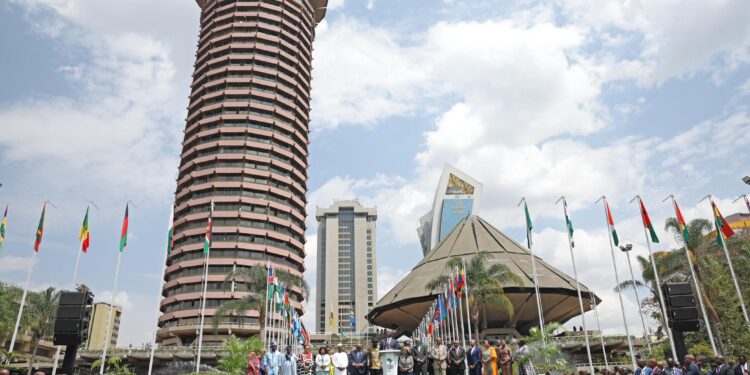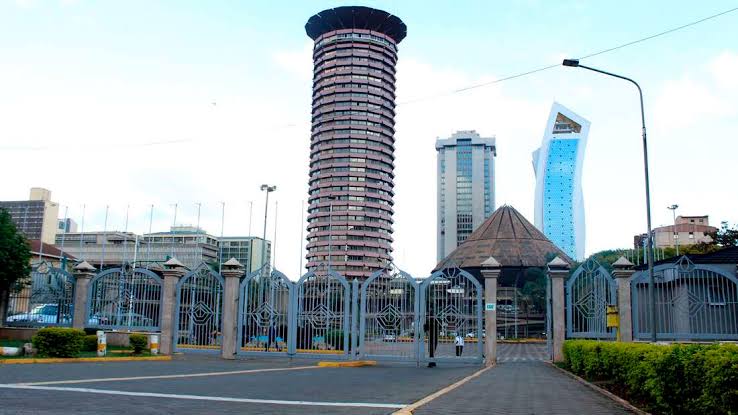In the heart of Nairobi, Kenya, stands the iconic Kenyatta International Convention Centre (KICC), a testament to architectural brilliance and historical significance.
Commissioned the late Mzee Jomo Kenyatta, the first President of the Republic of Kenya, in 1967, the KICC is not merely a building but a symbol of the nation’s aspirations and accomplishments.
Designed by the ingenious duo of Karl Henrik Nøstvik and David Mutiso, the KICC initially claimed the title of Nairobi’s tallest building during those years.
KICC’s construction unfolded in three phases, the first phase birthed the podium, followed by the construction of the main tower, and the grand finale—Phase III—marked the completion of the Plenary.

Further, the culmination of these efforts came to life in 1973, with a grand opening ceremony presided over by President Kenyatta himself.
In a significant shift in 2013, the complex, celebrating its 40th anniversary, was renamed the Kenyatta International Convention Centre, signifying its pivotal role in hosting international conferences and events.
KICC Architectural Features
The KICC reaches over 105 meters into the sky, adorned with a light terracotta façade that pays homage to traditional African architecture.
Its structure, consisting of 32 floors, includes a captivating revolving restaurant offering panoramic views, a symbol of the building’s timeless allure.
The Amphitheatre, where “heritage and modernity meet,” and the Tsavo Ballroom, East Africa’s largest conference chamber, showcase the architectural prowess behind the KICC.
Also, these spaces, designed for diverse gatherings, reflect the fusion of aesthetics and functionality.
The Visionary Architects
At the core of this architectural masterpiece is David Mutiso, the first indigenous Kenyan architect.
Born in 1932, David’s educational journey from Alliance High School to the University of Sheffield’s School of Architecture laid the foundation for his illustrious career.
His collaboration with Norwegian architect Karl Henrik Nøstvik shaped the KICC’s vision, dispelling misconceptions about the tower’s origin.
In an interview, David shared the unconventional inspiration behind the KICC—a donkey’s anatomy, a vision initially articulated by President Jomo Kenyatta himself.
Despite the tower’s subsequent evolution, David remained the visionary force, dispelling claims that Nøstvik solely engineered the project.

Other Projects Apart from KICC
David Mutiso’s impact transcends that of KICC.
As the first African Chief Architect in the Ministry of Public Works, he pioneered groundbreaking projects, leaving an indelible mark on Kenya’s architectural landscape.
Additionally, his commitment to excellence, rejection of bribery, and a dedication to urban planning have shaped both iconic structures and entire communities.
Beyond the blueprints and constructions, David Mutiso, an avid golfer and a man of many firsts, has previously said the story behind the structures, revealing a life intertwined with Kenya’s growth and architectural evolution.
Also Read: From Torture Chambers to Crime Scene: The Story of Nyayo House
Mutiso played a pivotal role in the master planning and design of the Buruburu housing project, aimed at providing homes for middle-income Kenyans.
However, the transformation of Buruburu over the years raised questions about policy formulation and implementation, shedding light on the challenges within urban planning and design.
His involvement in projects like the United Nations accommodation and the Kenya Technical Teachers College showcased a nuanced approach to architecture, blending structure with non-structural elements to create spaces that transcended mere functionality.
Life Beyond Architecture
David Mutiso’s journey, however, extends far beyond the drafting table and architectural blueprints.
An embodiment of resilience and determination, David’s legacy goes beyond the KICC, encompassing a tenure as the first African Chief Architect in the Ministry of Public Works from 1967 to 1974.
Despite facing challenges and attempts to derail his career due to his refusal to succumb to bribery, he stood firm, leaving a lasting impact on Kenya’s architectural landscape.
Furthermore, his commitment to rejecting corruption and upholding ethical standards became a hallmark of his career.
Also Read: KICC, Kenya Pipeline Among 11 State Companies Listed for Privatization
His resilience led him to become the Architectural Association of Kenya (AAK) Member Number 005, standing alongside four European pioneers in the Architectural Association of Kenya.
As a chairman of the Board of Registration for Architects and Quantity Surveyors (BORAQS) he played a vital role in shaping the professional standards and ethical considerations within the architectural community.
His involvement in international bodies like the East African Institute of Architects (EAIA) and Commonwealth Association of Architects (CAA) attests to his global impact and recognition within the architectural realm.
KICC Lasting Impression
As the KICC remains an enduring symbol of architectural excellence in Nairobi, David Mutiso’s story adds a profound layer to its narrative.
Beyond the bricks and mortar, it’s a tale of resilience, vision, and a commitment to ethical practices in an ever-evolving field.
As we gaze upon the KICC’s silhouette against Nairobi’s skyline, let it serve as a reminder not only of architectural prowess but of the indomitable spirit of a man who shaped Kenya’s architectural landscape and left an indelible mark on the nation’s history.
David Mutiso’s legacy lives on, not just in concrete and steel but in the very fabric of Kenya’s architectural identity.























































![Senator Allan Chesang And Chanelle Kittony Wed In A Colourful Ceremony [Photos] Trans Nzoia Senator Allan Chesang With Channelle Kittony/Oscar Sudi]( https://thekenyatimescdn-ese7d3e7ghdnbfa9.z01.azurefd.net/prodimages/uploads/2025/11/Trans-Nzoia-Senator-Allan-Chesang-with-Channelle-KittonyOscar-Sudi-360x180.png)


















